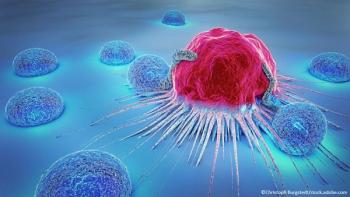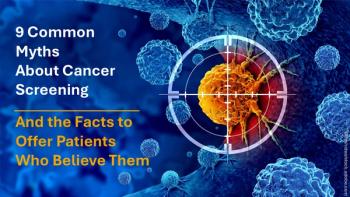
ASTRO: Post-Radiation PSA Bounce Common But Not a Worry
PHILADELPHIA -- External-beam radiation or brachytherapy for prostate cancer sometimes triggers a spike in prostate specific antigen levels, but researchers here said this "bounce" is not clinically significant.
PHILADELPHIA, Nov.8 -- External-beam radiation or brachytherapy for prostate cancer sometimes triggers a spike in prostate specific antigen levels, but researchers here said this "bounce" is not clinically significant.
Analysis of retrospective data from more than 7,500 prostate cancer patients revealed that a temporary increase in PSA did not significantly increase the risk of distant metastases, nor did it adversely affect prostate-specific survival or overall survival, said Eric Horwitz, M.D., of the Fox Chase Cancer Center here.
"Bounce is fairly common, but can be very stressful if patients or clinicians interpret the increase as a sign that the cancer has come back," Dr. Horwitz said in an interview during the American Society of Therapeutic Radiation Oncology meeting.
After 10 years the rate of freedom from distant metastases was 93.9% among radiation therapy patients who didn't have a PSA bounce versus 94.5% among those who did, he said. Likewise the rate of disease-specific survival was 91.7% versus 93.2%, and overall survival was 64.5% versus 67.5%, all non-significant.
For brachytherapy patients the breakdown was similar-at 10 years 94.5% of no-bounce patients were free of distant metastases versus 96.9% of bounce patients, disease-specific survival was 94.3% versus 96.3%, and overall survival was 62.5% versus 66.3% (NS for all).
The key message, he said, is "that when a spike occurs, it is useful to monitor the patient and repeat PSA again in six months, rather than initiating any additional treatment."
He said that these temporary spikes, which he defined as increases of at least 0.2 ng/mL over a previous PSA, usually occur one to three years after therapy.
Bounce is distinguished from biochemical failure because it goes back down and it doesn't usually increase by more than 1.2 ng/mL, he said.
The 10-year biochemical failure rate for radiation therapy patients who did not experience bounce during the first three years following treatment was 53% versus 55% for patients who did experience bounce within three years of treatment (P=0.83), and for brachytherapy the rates were 72% for patients who didn't experience bounced versus 62% for those who did (P=0.26).
He and his colleagues reviewed data from 4,839 patients with T1-2 prostate cancer who were treated with radiation therapy and 2,693 who were treated with brachytherapy.
The radiation therapy patients were treated at nine institutions from 1989 to 1995 and the brachytherapy patients were culled from patient records at 11 institutions form 1988 to 1998.
He said that 18.6% of the radiation therapy patients and 17.5% of the brachytherapy patients had at least one PSA bounce following treatment.
Bounce was less common among older patients. He reported that 78.4% of patients ages 70 or younger were bounce-free at five years versus 82.3% of patients ages 80 or older (P=0.02) for brachytherapy patients.
The isotope used in brachytherapy was also a factor in predicting bounce-risk. In all, 78.1% of patients treated with I-125 were bounce-free at five years versus 82.6% of patients seeded with Pd-103 (P=0.04).
Newsletter
Enhance your clinical practice with the Patient Care newsletter, offering the latest evidence-based guidelines, diagnostic insights, and treatment strategies for primary care physicians.






















































































































































































































































































